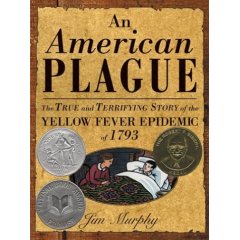Genre 4: Nonfiction: Orbis Pictus Award Winner

1. BIBLIOGRAPHY
Murphy, Jim. 2003. AN AMERICAN PLAGUE: THE TRUE AND TERRIFYING STORY OF THE YELLOW FEVER EPIDEMIC OF 1793. New York: Clarion.
ISBN 0395776082
2. PLOT SUMMARY
Murphy deftly chronicles the yellow fever epidemic of 1793 that struck the then capital city of Philadelphia. Day by day, and week by week, Murphy exposes the fear felt in the city, first hand accounts of those who stayed throughout the epidemic, and those who fled, including President George Washington. As doctors and caretakers fled the city, many died from the disease with no water or anyone to care for them. Heroes of the day turned out to be members of the Free African Society, who tended to the sick and were thought to be immune to the plague. Tragically, they were not immune, and many fell sick and died. Then, rather than being heralded, they were vilified in Mathew Carey's book, A SHORT ACCOUNT OF THE MALIGNANT FEVER, LATELY PREVALENT IN PHILADELPHIA; "The great demand for nurses afforded an opportunity for imposition, which was eagerly seized by some of the vilest of the blacks." Various theories as to the etiology of the disease are explored, as are treatments that were given such as blood letting and purging. Renowned physicians disagreed bitterly in the press regarding causes and cures. The eventual cause of the plague is finally discovered, the Aedes aegypti mosquito, and attempts were then made to reduce the mosquito population.
3. CRITICAL ANALYSIS
The accuracy of Murphy's book is first rate for numerous reasons; he is well-known in his field for his historic nonfiction titles, what is known and what is simply speculated is clearly differentiated, and reference aids are included. A detailed and thorough list of sources is included, as is an index. In his list of sources, Murphy even includes personal notes of interest, such as discussing his favorite entry of Elizabeth Drinker in EXTRACTS FROM THE JOURNAL OF ELIZABETH DRINKER, FROM 1759 TO 1807. The organization of the book is also exemplary, as Murphy shows what was occurring each day, from setting the scene on the hot, swampy streets of Philadelphia on August 3, 1793, to January 8, 1794, when the disease and the fear had both abated. A table of contents is in the front of the book, and chapter titles and subheadings provide information as to what is in each chapter. Black and white illustrations are throughout the book, and they help the reader to feel the spread and despair of the outbreak. Lists of the dead from the newspapers are shown, as are newspaper articles, and portraits of the important figures. Each illustration's source is given as well. Murphy's style invites the reader to explore this terrible time in our nation's history. First hand accounts of families and their losses enable the reader to visualize what it must have been like during this terrifying period. The many tragedies of this disease are uncovered, with easy to comprehend text that even reluctant readers should enjoy reading. Murphy closes the book by making it clear that there is still no cure for yellow fever, and we may yet be exposed to its plague.
4. REVIEW EXCERPTS
SCHOOL LIBRARY JOURNAL (STARRED): "Black-and-white reproductions of period art, coupled with chapter headings that face full-page copies of newspaper articles of the time, help bring this dreadful episode to life."
BOOKLIST: "History, science, politics, and public health come together in this dramatic account of the disastrous yellow fever epidemic that hit the nation's capital more than 200 years ago."
A NEWBERY HONOR BOOK
WINNER OF THE ROBERT F. SIBERT MEDAL
NATIONAL BOOK AWARD FINALIST
ORBIS PICTUS AWARD WINNER
5. CONNECTIONS
* Look at other mosquito borne diseases including Malaria, West Nile Virus, and Heartworm disease in cats. See how these diseases are transmitted and compare to yellow fever.
* Look at what is being done to eradicate mosquitoes. What else could be done? Is it likely that we will ever be able to eliminate them and the diseases they carry?
* Murphy's sources contain a wealth of information to explore, including sources about yellow fever, Philadelphia and George Washington.
* Read fictionalized accounts of yellow fever:
FEVER, 1793 by Laurie Halse Anderson
ISBN 0689848919
PATH OF THE PALE HORSE by Paul Fleischman
ISBN 0064404420

0 Comments:
Post a Comment
<< Home